Poulan PRRT900 User Manual
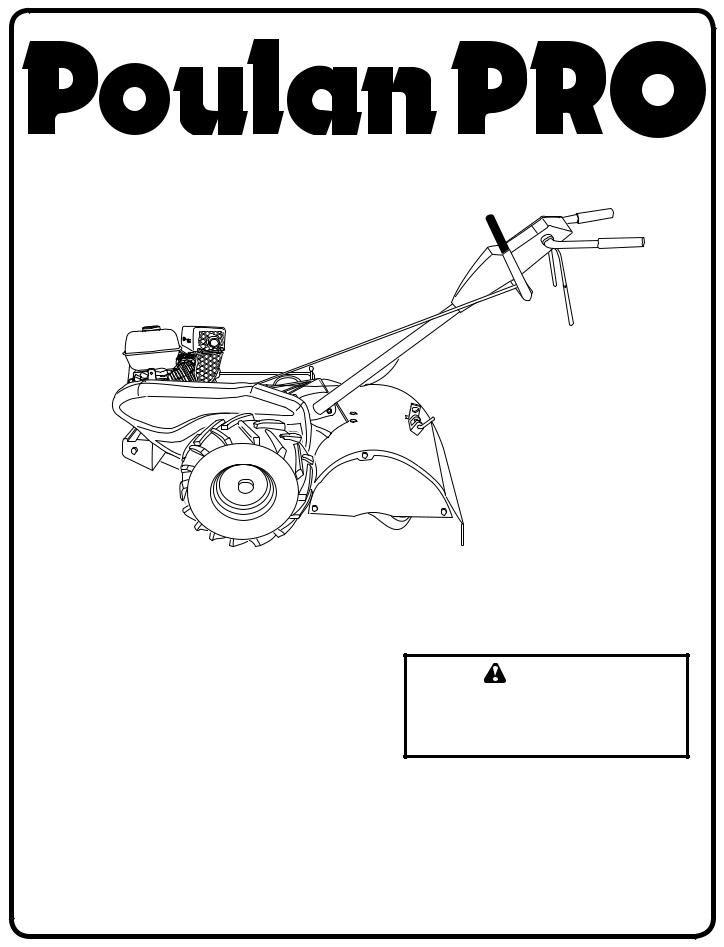
IMPORTANT MANUAL |
Do Not Throw Away |
OPERATOR'S MANUAL
MODEL:
PRRT900
REAR TINE TILLER
WARNING:
Read this Manual and follow all Warnings and Safety Instructions. Failure to do so can result in serious injury.
ALWAYS WEAR EYE PROTECTION DURING OPERATION Visit our website: www.poulan-pro.com
427910 03.11.08 CL |
Printed in U.S.A. |

SAFETY RULES
Safe Operation Practices for Walk-Behind Powered Rotary Tillers
TRAINING
•Read the Manual carefully. Be thoroughly familiar with the controls and the proper use of the equipment. Know how to stop the unit and disengage the controls quickly.
•Never allow children to operate the equipment. Never allow adults to operate the equipment without proper instruction.
•Keep the area of operation clear of all persons, particularly small children, and pets.
•Never operate the tiller without proper guards, plates, or other safety protective devices in place.
•Keep children and pets away.
•Do not overload the machine capacity by attempting to till too deep at too fast a rate.
•Never operate the machine at high speeds on slippery surfaces. Look behind and use care when backing.
•Never allow bystanders near the unit.
•Use only attachments and accessories approved by the manufacturer of the tiller.
PREPARATION
•Thoroughly inspect the area where the equipment is to be used and remove all foreign objects.
•Disengage all clutches and shift into neutral before starting the engine (motor).
•Never operate the tiller without good visibility or light.
•Be careful when tilling in hard ground. The tines may catch in the ground and propel the tiller forward. If this occurs, let go of the handlebars and do not restrain the machine.
•Do not operate the equipment without wearing adequate outer garments. Wear footwear that will improve footing on slippery surfaces.
•Handle fuel with care; it is highly flammable.
•Use an approved fuel container.
•Never add fuel to a running engine or hot engine.
•Fill fuel tank outdoors with extreme care. Never fill fuel tank indoors.
•Replace gasoline cap securely and clean up spilled fuel before restarting.
•Use extension cords and receptacles as specified by the manufacturer for all units with electric drive motors or electric starting motors.
•Never attempt to make any adjustments while the engine (motor) is running (except where specifically recommended by manufacturer).
OPERATION
•Do not put hands or feet near or under rotating parts.
•Exercise extreme caution when operating on or crossing gravel drives, walks, or roads. Stay alert for hidden hazards or traffic. Do not carry passengers.
•After striking a foreign object, stop the engine (motor), remove the wire from the spark plug, thoroughly inspect the tiller for any damage, and repair the damage before restarting and operating the tiller.
•Exercise caution to avoid slipping or falling.
•If the unit should start to vibrate abnormally, stop the engine (motor) and check immediately for the cause. Vibration is generally a warning of trouble.
•Stop the engine (motor) when leaving the operating position.
•Take all possible precautions when leaving the machine unattended. Disengage the tines, shift into neutral, and stop the engine.
•Before cleaning, repairing, or inspecting, shut off the engine and make certain all moving parts have stopped. Disconnect the spark plug wire, and keep the wire away from the plug to prevent accidental starting. Disconnect the cord on electric motors.
•Do not run the engine indoors; exhaust fumes are dangerous.
2
MAINTENANCE AND STORAGE
•Keep machine, attachments, and accessories in safe working condition.
•Check shear pins, engine mounting bolts, and other bolts at frequent intervals for proper tightness to be sure the equipment is in safe working condition.
•Never store the machine with fuel in the fuel tank inside a building where ignition sources are present, such as hot water and space heaters, clothes dryers, and the like. Allow the engine to cool before storing in any enclosure.
•Always refer to the operator’s guide instructions for important details if the tiller is to be stored for an extended period.
- IMPORTANT -
CAUTIONS, IMPORTANTS, AND NOTES ARE A MEANS OF ATTRACTING ATTENTION TO IMPORTANT OR CRITICAL INFORMATION IN THIS MANUAL.
IMPORTANT: USED TO ALERT YOU THAT THERE IS A POSSIBILITY OF DAMAGING THIS EQUIPMENT.
NOTE: Gives essential information that will aid you to better understand, incorporate, or execute a particular set of instructions.
Look for this symbol to point out important safety precautions. It means CAUTION!!! BECOME ALERT!!! YOUR SAFETY IS INVOLVED.
CAUTION: Always disconnect spark plug wire and place wire where it cannot contact spark plug in order to prevent accidental starting when setting up, transporting, adjusting or making repairs.
 WARNING
WARNING
The engine exhaust from this product contains chemicals known to the State of California to cause cancer, birth defects, or other reproductive harm.

PRODUCT SPECIFICATIONS
Gasolina Capacity: |
3 Quarts (2.8L) |
|
Unleaded Regular |
|
|
Oil (API-SG-SL): |
SAE 30 (Above 32°F) |
(Capacity: 20 oz./0.6L) |
SAE 5W-30 (Below 32°F) |
|
|
Spark Plug : |
NGK-BPR6ES |
(Gap: .030"/0.76mm) |
TORCH-F6RTC |
|
|
CONGRATULATIONS on your purchase of a new tiller. It has been designed, engineered and manufactured to give you the best possible dependability and performance.
Should you experience any problems you cannot easily remedy, please contact your nearest authorized service center. We have competent, well-trained technicians and the proper tools to service or repair this unit.
Please read and retain this manual. The instructions will enable you to assemble and maintain your tiller properly. Always observe the “SAFETY RULES”.
CUSTOMER RESPONSIBILITIES
•Read and observe the safety rules.
•Follow a regular schedule in maintaining, caring for and using your tiller.
•Follow instructions under “Maintenance” and “Storage” sections of this Owner’s Manual.
WARNING: This unit is equipped with an internal combustion engine and should not be used on or near any unimprovedforest-covered,brush-coveredorgrasscovered land unless the engine's exhaust system is equipped with a spark arrester meeting applicable local laws (if any). If a spark arrester is used, it should be maintained in effective working order by the operator.
In the state of California, a spark arrester is required by law (Section 4442 of the California Public Resources Code). Other states may have similar laws. Federal laws apply on federal lands. See your authorized service center/ DEPARTMENT for spark arrester.
TABLE OF CONTENTS
SAFETY RULES .......................................................... |
2 |
CUSTOMER RESPONSIBILITIES............................... |
3 |
PRODUCT SPECIFICATIONS..................................... |
3 |
ASSEMBLY............................................................... |
4-6 |
OPERATION ........................................................... |
7-11 |
MAINTENANCE SCHEDULE .................................... |
12 |
MAINTENANCE ................................................... |
12-14 |
SERVICE & ADJUSTMENTS ............................... |
15-17 |
STORAGE.................................................................. |
18 |
TROUBLESHOOTING............................................... |
19 |
WARRANTY............................................................... |
21 |
3
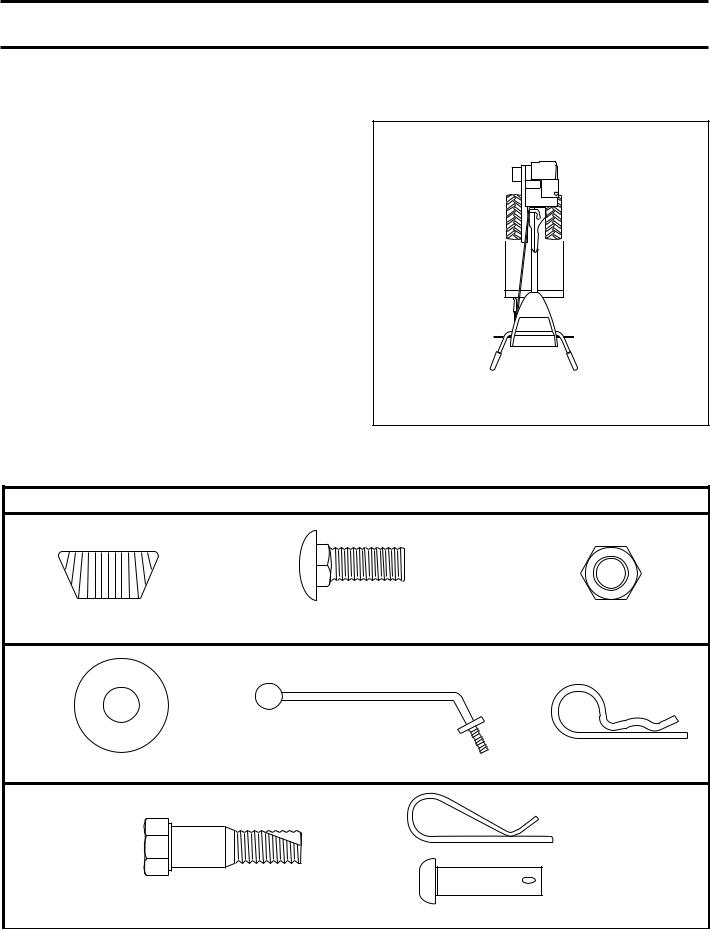
ASSEMBLY
Your new tiller has been assembled at the factory with exception of those parts left unassembled for shipping purposes. To ensure safe and proper operation of your tiller all parts and hardware you assemble must be tightened securely. Use the correct tools as necessary to insure proper tightness.
TOOLS REQUIRED FOR ASSEMBLY
A socket wrench set will make assembly easier. Standard wrench sizes are listed.
(1) Utility knife
(1) Tire pressure gauge
(1) Pair of pliers
(1) 9/16" wrench
OPERATOR’S POSITION (See Fig. 1)
When right or left hand is mentioned in this manual, it means when you are in the operating position (standing behind tiller handles).
FRONT
LEFT  RIGHT
RIGHT
OPERATOR’S
POSITION
Fig. 1
CONTENTS OF HARDWARE PACK |
|
|
(2) Handle Locks |
(1) Carriage Bolt |
(1) Center Locknut |
|
3/8-16 UNC x 1 Grade 5 |
3/8-16 UNC |
(1) Flat Washer 13/32 x 1 x 11 Gauge |
(1) Handle Lock Lever |
(1) Hairpin Clip |
(1) Pivot Bolt |
|
|
3/8-16 UNC Grade 5 |
Extra Shear Pins & Clips |
|
|
4 |
|
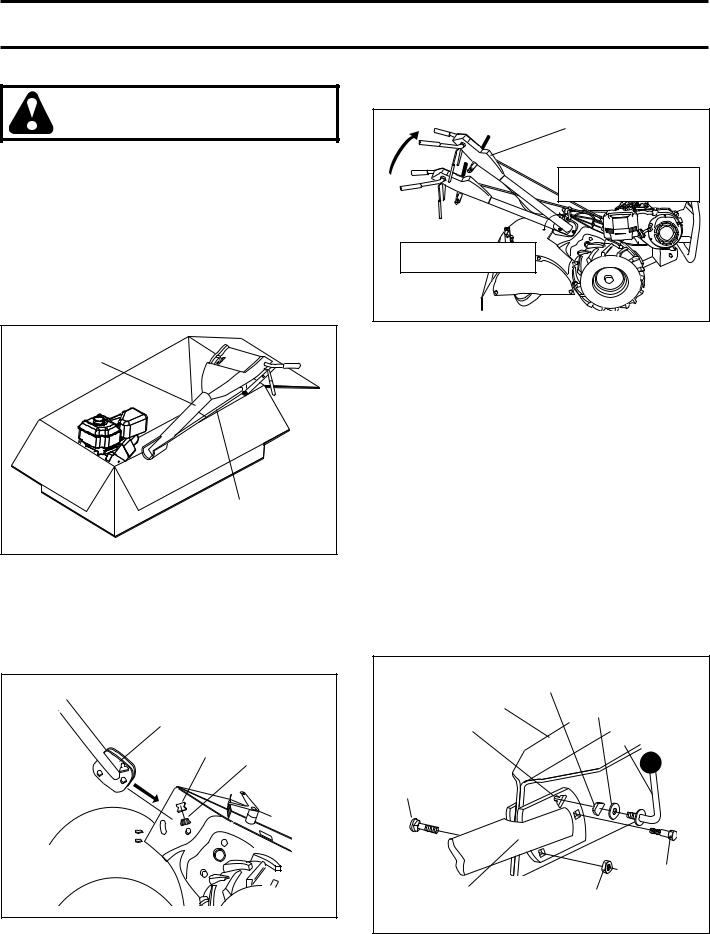
ASSEMBLY
UNPACKING CARTON (See Fig. 2)
CAUTION: Be careful of exposed staples when handling or disposing of cartoning material.
IMPORTANT: WHEN UNPACKING AND ASSEMBLING TILLER, BE CAREFUL NOT TO STRETCH OR KINK CABLES.
•While holding handle assembly, cut cable ties securing handle assembly to top frame and depth stake. Let handle assembly rest on tiller.
•Remove top frame of carton.
•Slowly ease handle assembly up and place on top of carton.
•Cut down right hand front and right hand rear corners of carton, lay side carton wall down.
•Remove packing material from handle assembly.
HANDLE |
|
|
|
ASSEMBLY |
|
|
|
|
|
|
3 |
|
|
_ |
|
|
n |
|
|
|
to |
|
|
ar |
|
|
|
c |
|
|
|
SHIFT ROD |
|||
Fig. 2
INSTALL HANDLE (See Figs. 3, 4, and 5)
•Insert one handle lock (with teeth facing outward) in gearcase notch. (Apply grease on smooth side of handle lock to aid in keeping lock in place until handle assembly is lowered into position.)
VIEWED FROM R.H. SIDE OF TILLER
HANDLE ASSEMBLY
GEARCASE
NOTCH
HANDLE
LOCK
Fig. 3
•Grasp handle assembly. Hold in “up” position. Be sure handle lock remains in gearcase notch. Slide handle assembly into position.
HANDLE ASSEMBLY |
"UP" POSITION |
TIGHTEN HANDLE LOCK |
LEVER TO HOLD |
LOOSEN HANDLE |
LOCK LEVER TO MOVE |
Fig. 4
•Rotate handle assembly down. Insert rear carriage bolt first, with bolt head on L.H. side of tiller and loosely assemble locknut (See Fig. 5).
•Insert pivot bolt in front part of plate and tighten.
•Cut down remaining corners of carton and lay panels flat.
•Lower the handle assembly. Tighten nut on carriage bolt so handle moves with some resistance. This will allow for easier adjustment.
•Place flat washer on threaded end of handle lock lever.
•Insert handle lock lever through handle base and gearcase. Screw in handle lock lever just enough to hold lever in place.
•Insert second handle lock (with teeth inward) in the slot of the handle base (just inside of washer).
•With handle assembly in lowest position, securely tighten handle lock lever by rotating clockwise. Leaving handle assembly in lowest position will make it easier to remove tiller from carton.
|
|
HANDLE |
|
|
LOCK |
GEARCASE |
FLAT |
|
|
|
WASHER |
SLOT |
|
HANDLE LOCK |
|
|
|
|
|
LEVER |
CARRIAGE |
|
|
BOLT |
|
|
|
4 |
|
_3 |
PIVOT BOLT |
|
dles |
|
|
han |
|
|
|
|
|
HANDLE |
|
LOCKNUT |
BASE |
|
|
Fig. 5
5
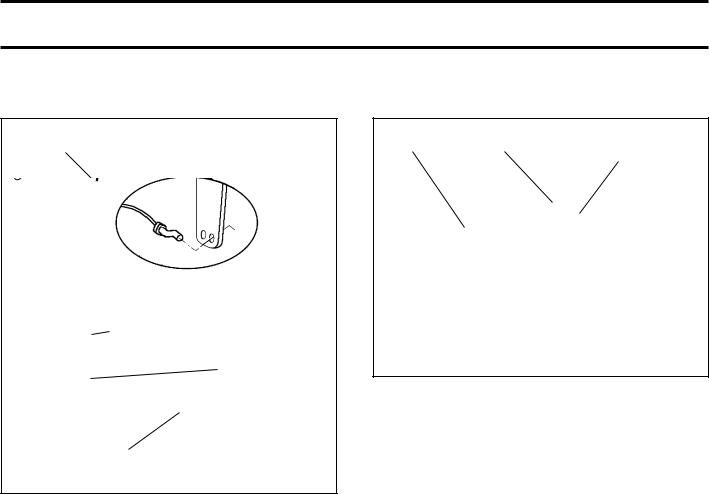
ASSEMBLY
ATTACH CLUTCH CABLE (See Fig. 6)
•Hook end of clutch cable through hole in control bar bracket.
CONTROL BAR
BRACKET
END OF CLUTCH
CABLE
Fig. 6
CONNECT SHIFT ROD (See Fig. 7)
•Insert end of shift rod into hole of shift lever indicator.
•Insert hairpin clip through hole of shift rod to secure.
SHIFT |
HAIRPIN |
SHIFT |
|
CLIP |
LEVER |
||
ROD |
|||
|
INDICATOR |
||
|
|
Fig. 7
REMOVE TILLER FROM CRATE
•Make sure shift lever indicator is in “N” position (See Fig. 7)
•Tilt tiller forward by lifting handle. Separate cardboard cover from leveling shield.
•Rotate tiller handle to the right and pull tiller out of carton.
CHECK TIRE PRESSURE
The tires on your unit were overinflated at the factory for shipping purposes. Correct and equal tire pressure is important for best tilling performance.
•Reduce tire pressure to 20 PSI (1.4 kg/cm2).
HANDLE HEIGHT
•Handle height may be adjusted to better suit operator. (See “TO ADJUST HANDLE HEIGHT” in the Service and Adjustments section of this manual).
6
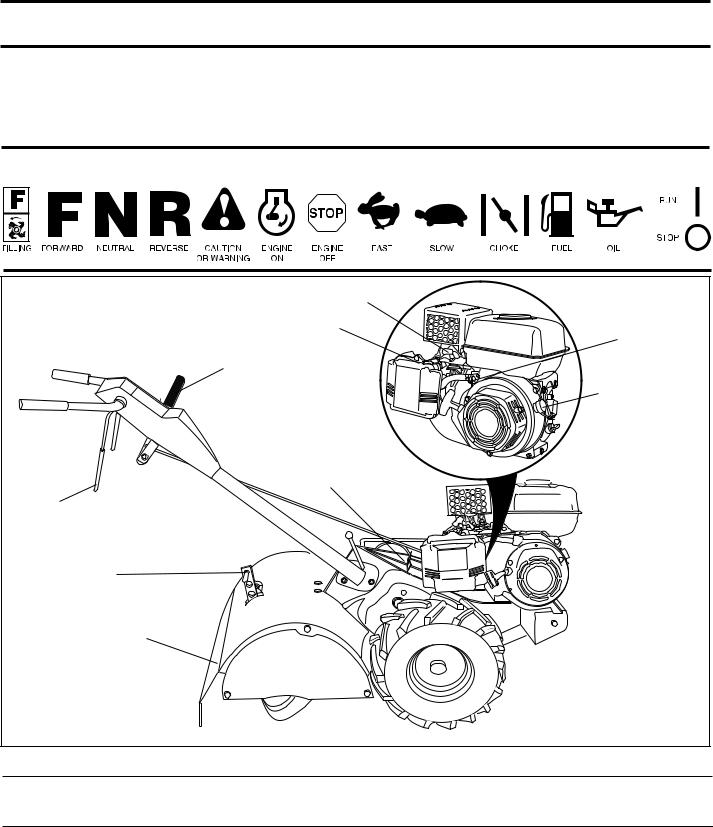
OPERATION
KNOW YOUR TILLER
READ THIS OWNER'S MANUAL AND SAFETY RULES BEFORE OPERATING YOUR TILLER.
Compare the illustrations with your tiller to familiarize yourself with the location of various controls and adjustments. Save this manual for future reference.
These symbols may appear on your Tiller or in literature supplied with the product. Learn and understand their meaning.
THROTTLE CONTROL |
|
CHOKE CONTROL |
FUEL |
|
|
|
VALVE |
SHIFT LEVER |
|
|
ON/OFF |
|
SWITCH |
SHIFT LEVER INDICATOR |
|
DRIVE |
|
CONTROL |
|
BAR |
|
DEPTH STAKE |
|
LEVELING |
|
SHIELD |
|
Fig. 8
MEETS ANSI SAFETY REQUIREMENTS
Our tillers conform to the safety standards of the American National Standards Institute.
CHOKE CONTROL - Used when starting a cold engine. DEPTH STAKE - Controls depth at which tiller will dig. DRIVE CONTROL BAR - Used to engage tines. LEVELING SHIELD - Levels tilled soil.
ON / OFF switch - used to STOP the engine. FUEL VALVE - Used to turn fuel off and on.
RECOIL STARTER HANDLE - Used to start the engine. SHIFT LEVER - Used to shift transmission gears.
SHIFT LEVER INDICATOR - Shows which gear the transmission is in.
THROTTLE CONTROL - Controls engine speed.
7
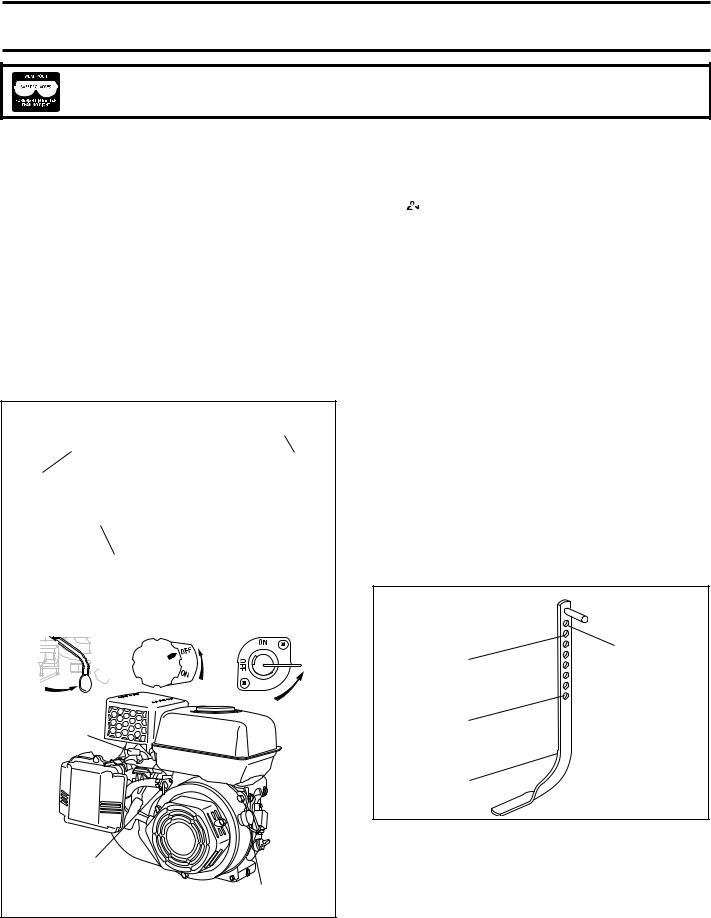
OPERATION
The operation of any tiller can result in foreign objects thrown into the eyes, which can result in severe eye damage. Always wear safety glasses or eye shields before starting your tiller and while tilling. We recommend a wide vision safety mask for over spectacles or standard safety glasses.
00155
HOW TO USE YOUR TILLER
Know how to operate all controls before adding fuel and oil or attempting to start engine.
STOPPING (See Fig. 9)
TINES
1.Release drive control to stop movement.
2.Move shift lever to “N” (neutral) position.
ENGINE
2.Move throttle control to “SLOW” position and allow the engine to run slowly for cool down.
3.Turn the engine switch to the "OFF" Position.
4.Turn the fuel valve lever to the "OFF" Position.
NOTE: NEVER USE CHOKE TO STOP ENGINE.
IMPORTANT: TO STOP ENGINE IN AN EMERGENCY, TURN THE ENGINE SWITCH TO THE OFF POSITION.
|
|
SHIFT |
|
|
LEVER |
DRIVE CONTROL |
|
|
BAR |
|
|
“ENGAGED” |
|
|
POSITION |
|
|
DRIVE CONTROL BAR |
|
|
“DISENGAGED” POSITION |
|
|
THROTTLE |
ENGINE |
FUEL |
CONTROL |
SWITCH |
VALVE |
THROTTLE |
|
|
CONTROL |
|
|
FUEL |
|
|
VALVE |
|
|
|
|
ENGINE |
|
|
SWITCH |
Fig. 9
TINE OPERATION - WITH WHEEL DRIVE
•Always release drive control bar before moving shift lever into another position.
•Tine movement is achieved by moving shift lever to
( ) till position and engaging drive control bar.
) till position and engaging drive control bar.
FORWARD - WHEELS ONLY/TINES STOPPED
•Release drive control bar and move shift lever indicator to “F” (forward) position. Engage drive control bar and tiller will move forward.
REVERSE - WHEELS ONLY/TINES STOPPED
•DO NOT STAND DIRECTLY BEHIND TILLER.
•Release the drive control bar.
•Move throttle control to “SLOW” position.
•Move shift lever indicator to “R” (reverse) position.
•Hold drive control bar against the handle to start tiller movement.
HARD TO SHIFT GEARS
•Briefly engage drive control bar and release or rock tiller forward and backward until are able to shift gears.
DEPTH STAKE (See Fig. 10)
The depth stake can be raised or lowered to allow you more versatile tilling and cultivating, or to more easily transport your tiller.
SHALLOWEST TILLING (CULTIVATING)
DEEPEST
TILLING
DEPTH
STAKE
TRANSPORT
POSITION
|
|
|
|
|
|
2 |
|
|
|
|
|
_ |
|
|
|
|
|
e |
|
|
|
|
|
k |
|
|
|
|
|
ta |
|
|
|
|
|
s |
|
|
|
|
|
_ |
|
|
|
|
|
|
pth |
|
|
|
|
|
|
Fig. 10
TILLING (See Fig. 11)
•Release depth stake pin. Pull the depth stake up for increased tilling depth. Place depth stake pin in hole of depth stake to lock in position.
•Place shift lever indicator in tilling position.
•Hold the drive control bar against the handle to start tilling movement. Tines and wheels will both turn.
8
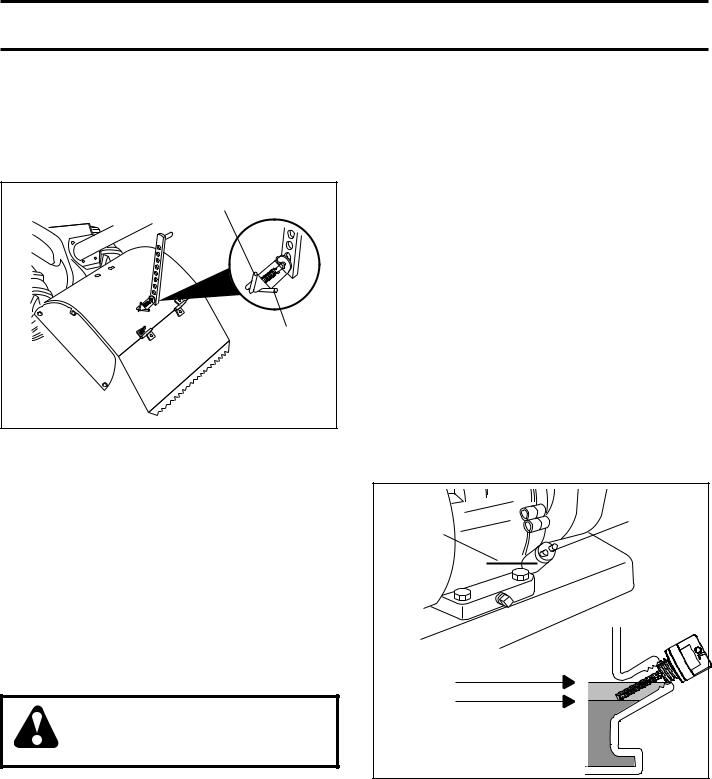
OPERATION
•Move throttle control to “FAST” position for deep tilling. To cultivate, throttle control can be set at any desired speed, depending on how fast or slow you wish to cultivate.
IMPORTANT: ALWAYS RELEASE DRIVE CONTROL BAR BEFORE MOVING SHIFT LEVER INTO ANOTHER POSITION.
DEPTH STAKE PIN |
||
“RELEASED” POSITION |
||
|
|
“LOCKED” |
|
|
POSITION |
|
|
6 |
|
|
1 |
|
|
_ |
|
e |
|
k |
|
|
ta |
|
|
s |
|
|
_ |
|
|
h |
|
|
pt |
|
|
de |
|
|
Fig. 11
TURNING
•Release the drive control bar.
•Move throttle control to “SLOW” position.
•Place shift lever indicator in “F” (forward) position. Tines will not turn.
•Lift handle to raise tines out of ground.
•Swing the handle in the opposite direction you wish to turn, being careful to keep feet and legs away from tines.
•When you have completed your turn-around, release the drive control bar and lower handle. Place shift lever in till position and move throttle control to desired speed. To begin tilling, hold drive control bar against the handle.
TO TRANSPORT
CAUTION: Beforeliftingortransporting, allow tiller engine and muffler to cool. Disconnect spark plug wire. Drain gasoline from fuel tank.
AROUND THE YARD
•Release the depth stake pin. Move the depth stake down to the top hole for transporting the tiller. Place depth stake pin in hole of depth stake to lock in position. This prevents tines from scuffing the ground.
•Place shift lever indicator in “F” (forward) position for transporting.
•Hold the drive control bar against the handle to start tiller movement. Tines will not turn.
•Move throttle control to desired speed.
AROUND TOWN
•Disconnect spark plug wire.
•Drain fuel tank.
•Transport in upright position to prevent oil leakage.
BEFORE STARTING ENGINE
IMPORTANT: BE VERY CAREFUL NOT TO ALLOW DIRT TO ENTER THE ENGINE WHEN CHECKING OR ADDING OIL OR FUEL. USE CLEAN OIL AND FUEL AND STORE IN APPROVED, CLEAN, COVERED CONTAINERS. USE CLEAN FILL FUNNELS.
FILL ENGINE WITH OIL (See Fig. 12)
1.Remove hangtag from engine.
2.With engine level, remove engine oil filler plug.
3.Fill engine with oil to point of overflowing. For approximate capacity see “PRODUCT SPECIFICATIONS” on page 4 of this manual. All oil must meet A.P.I. Service Classification SG-SL.
4.Tilt tiller back on its wheels and then re-level.
5.With engine level, refill to point of overflowing if necessary. Replace oil filler plug.
•For cold weather operation you should change oil for easier starting (See “OIL VISCOSITY CHART” in the Maintenance section of this manual).
•To change engine oil, see the Maintenance section of this manual.
Oil Level |
|
|
|
|
Oil Filler Plug |
|
|
|
|
|
|
|
|
|
|
|
4 |
|
|
|
|
_ |
|
|
|
|
rt |
|
|
|
|
a |
|
|
|
|
_ |
|
|
|
|
e |
|
|
|
|
|
in |
|
|
|
|
|
ng |
|
|
|
|
|
e |
|
|
|
|
|
Max Upper Level |
|||||
Min Lower Level |
|||||
Fig. 12
9
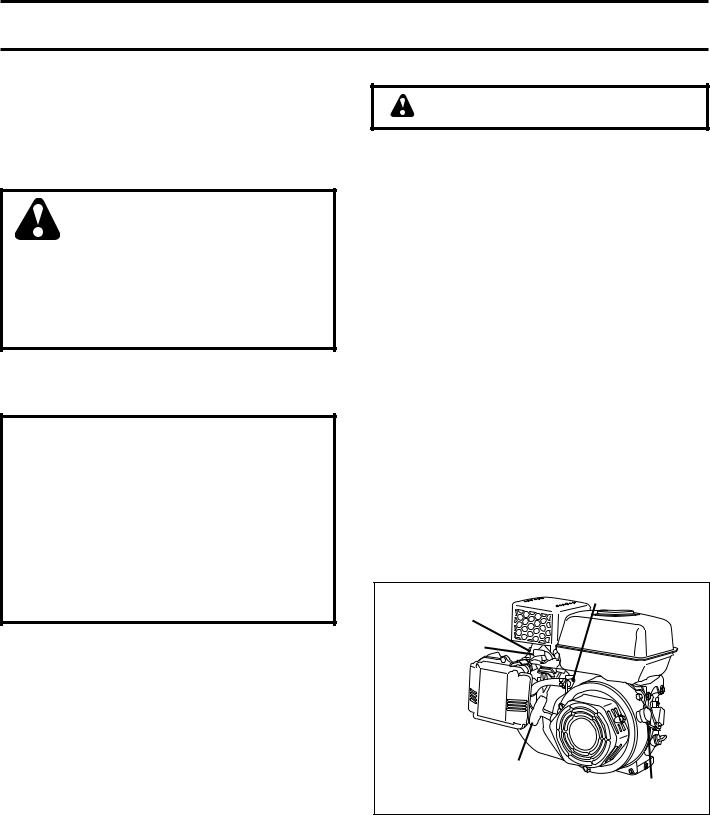
OPERATION
ADD GASOLINE
•Fill fuel tank to bottom of filler neck. Do not overfill. Use fresh, clean, regular unleaded gasoline with a minimum of 87 octane. (Use of leaded gasoline will increase carbon and lead oxide deposits and reduce valve life). Do not mix oil with gasoline. Purchase fuel in quantities that can be used within 30 days to assure fuel freshness.
CAUTION: Fill to within 1/2 inch of top of fuel tank to prevent spills and to allow for fuel expansion. If gasoline is accidentally spilled, move machine away from area of spill. Avoid creating any source of ignition until gasoline vapors have disappeared.
Wipe off any spilled oil or fuel. Do not store, spill or use gasoline near an open flame.
IMPORTANT: WHEN OPERATING IN TEMPERATURES BELOW32°F(0°C), USE FRESH, CLEAN WINTER GRADE GASOLINE TO HELP INSURE GOOD COLD WEATHER STARTING.
CAUTION: Alcohol blended fuels (called gasohol or using ethanol or methanol) can attract moisture which leads to separation and formation of acids during storage. Acidic gas can damage the fuel system of an engine while in storage. To avoid engine problems, the fuel system should be emptied before storage of 30 days or longer. Drain the gas tank, start the engine and let it run until the fuel lines and carburetor are empty. Use fresh fuel next season. See Storage Instructions for additional information. Never use engine or carburetor cleaner products in the fuel tank or permanent damage may occur.
TO START ENGINE (See Fig. 13)
CAUTION: KEEP TINE CONTROL IN “OFF”
POSITION WHEN STARTING ENGINE.
When starting engine for the first time or if engine has run out of fuel, it will take extra pulls of the recoil starter to move fuel from the tank to the engine.
1.Make sure spark plug wire is properly connected.
2.Place the fuel valve to the "ON" position.
3.To start a cold engine, move the choke lever to the "ON" position.
4.Move the throttle lever away from the "SLOW" position, about 1/3 of the way toward the "FAST" position.
5.Turn the engine switch to the "ON" position. Pull rope out slowly until engine reaches start of compression cycle (rope will pull slightly harder at this point).
6.Pull recoil starter handle quickly. Do not let starter handle snap back against starter. Repeat if necessary.
NOTE: IF ENGINE FIRES BUT DOES NOT START, MOVE CHOKE CONTROL TO HALF CHOKE POSITION. PULL RECOIL STARTER HANDLE UNTIL ENGINE STARTS.
7.If the choke lever has been moved to the "ON" position to start the engine, gradually move it to the opposite position as the engine warms up.
NOTE: A WARM ENGINE REQUIRES LESS CHOKING TO START.
8.Move throttle control to desired running position.
9.Allow engine to warm up for a few minutes before engaging tines.
NOTE: IFENGINEDOESNOTSTART,SEE TROUBLESHOOTING POINTS.
Fuel Valve
Spark Plug
Throttle Control
Choke
Control
Recoil Starter
Engine
Switch
Fig. 13
10
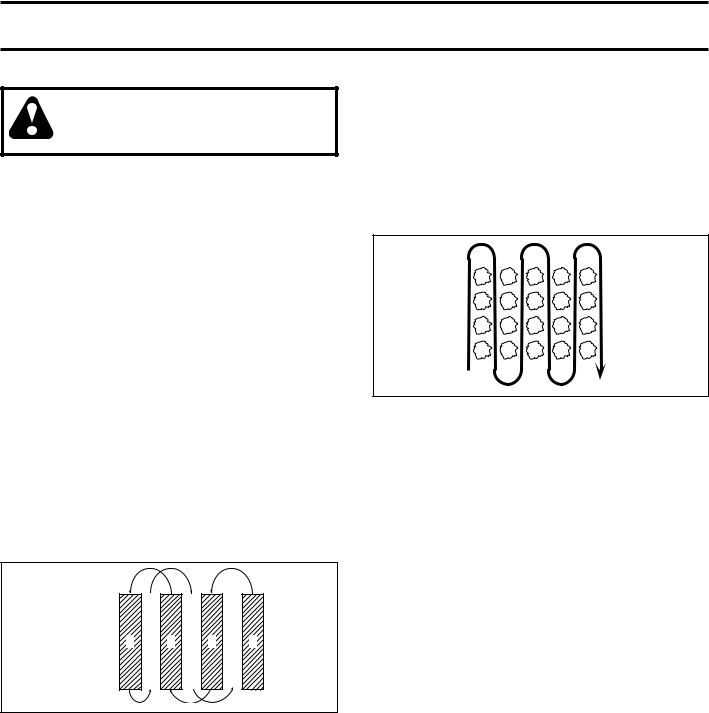
OPERATION
TILLING HINTS
CAUTION: Until you are accustomed to handling your tiller, start actual field use with throttle in slow position (mid-way between “FAST” and “IDLE”).
•Tilling is digging into, turning over, and breaking up packed soil before planting. Loose, unpacked soil helps root growth. Best tilling depth is 4" to 6" (10-15 cm). A tiller will also clear the soil of unwanted vegetation. The decomposition of this vegetable matter enriches the soil. Depending on the climate (rainfall and wind), it may be advisable to till the soil at the end of the growing season to further condition the soil.
•You will find tilling much easier if you leave a row untilled between passes. Then go back between tilled rows. (See Fig. 14) There are two reasons for doing this. First, wide turns are much easier to negotiate than about-faces. Second, the tiller won’t be pulling itself, and you, toward the row next to it.
•Soil conditions are important for proper tilling. Tines will not readily penetrate dry, hard soil which may contribute to excessive bounce and difficult handling of your tiller. Hard soil should be moistened before tilling; however, extremely wet soil will “ball-up” or clump during tilling. Wait until the soil is less wet in order to achieve the best results. When tilling in the fall, remove vines and long grass to prevent them from wrapping around the tine shaft and slowing your tilling operation.
•Do not lean on handle. This takes weight off the wheels and reduces traction. To get through a really tough section of sod or hard ground, apply upward pressure on handle or lower the depth stake.
4 |
3 |
2 |
1 |
5 |
6 |
|
7 |
Fig. 14
CULTIVATING
Cultivating is destroying the weeds between rows to prevent them from robbing nourishment and moisture from the plants. At the same time, breaking up the upper layer of soil crust will help retain moisture in the soil. Best digging depth is 1" to 3" (2.5-7.5 cm). Lower the outer side shields to protect small plants from being buried.
•Cultivate up and down the rows at a speed which will allow tines to uproot weeds and leave the ground in rough condition, promoting no further growth of weeds and grass (See Fig. 15).
Fig. 15
TINE SHEAR PINS
The tine assemblies on your tiller are secured to the tine shaft with shear pins (See “TINE REPLACEMENT” in the Service and Adjustments section of this manual).
If the tiller is unusually overloaded or jammed, the shear pins are designed to break before internal damage occurs to the transmission.
•If shear pin(s) break, replace only with those shown in the Repair Parts section of this manual.
11
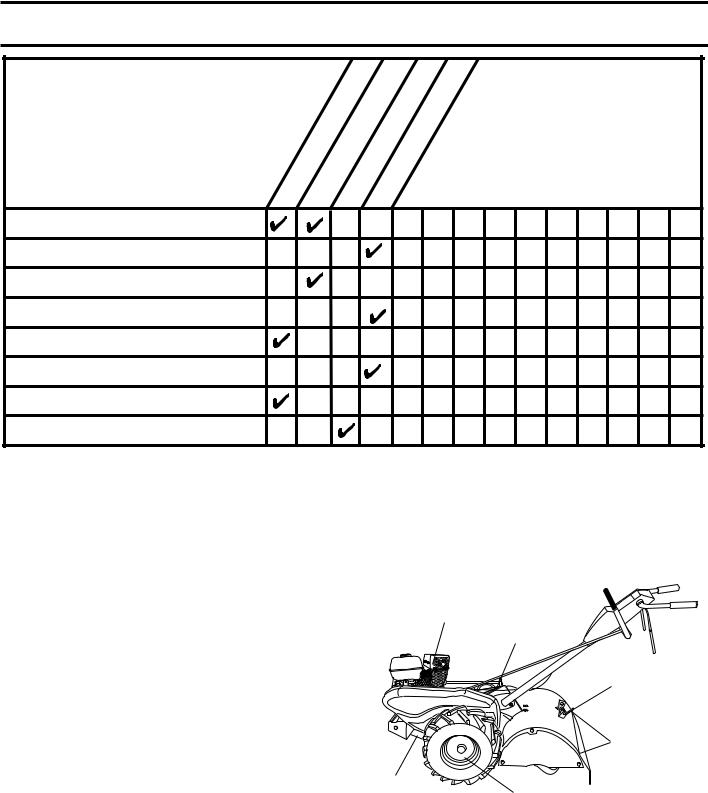
MAINTENANCE
-!).4%.!.#% 3#(%$5,%
&),,ª).ª$!4%3 !3ª9/5ª#/-0,%4% 2%'5,!2ª3%26)#%
"%&/2%ª%!#(ª53%%6%29ªª(/523%6%29ªª(/523%6%29ªª(/523
3%26)#%ª$!4%3
#HECKª%NGINEª/ILª,EVEL
#HANGEª%NGINEª/IL |
|
|
/ILª0IVOTª0OINTS
)NSPECTª3PARKª!RRESTERª ª-UFFLER
)NSPECTª!IRª3CREEN
#LEANªORª2EPLACEª!IRª#LEANERª#ARTRIDGE
#LEANª%NGINEª#YLINDERª&INS
2EPLACEª3PARKª0LUG
ª ª#HANGEªMOREªOFTENªWHENªOPERATINGªUNDERªAªHEAVYªLOADªORªINªHIGHªAMBIENTªTEMPERATURESª ª3ERVICEªMOREªOFTENªWHENªOPERATINGªINªDIRTYªORªDUSTYªCONDITIONS ª
GENERAL RECOMMENDATIONS
The warranty on this tiller does not cover items that have been subjected to operator abuse or negligence. To receive full value from the warranty, the operator must maintain tiller as instructed in this manual.
Some adjustments will need to be made periodically to properly maintain your tiller.
All adjustments in the Service and Adjustments section of this manual should be checked at least once each season.
•Once a year you should replace the spark plug, clean or replace air filter, and check tines and belts for wear. A new spark plug and clean air filter assure proper air-fuel mixture and help your engine run better and last longer.
BEFORE EACH USE
•Check engine oil level.
•Check tine operation.
•Check for loose fasteners.
LUBRICATION
Keep unit well lubricated (See “LUBRICATION CHART”).
LUBRICATION CHART
dENGINE eRH GEAR CASE
GREASE FITTING
cDEPTH
STAKE PIN
cLEVELING
SHIELD
HINGES
cIDLER |
cWHEEL |
BRACKET |
|
|
HUB |
cSAE 30 OR 10W-30 MOTOR OIL
dREFER TO MAINTENANCE “ENGINE” SECTION
eEP #1 GREASE
12
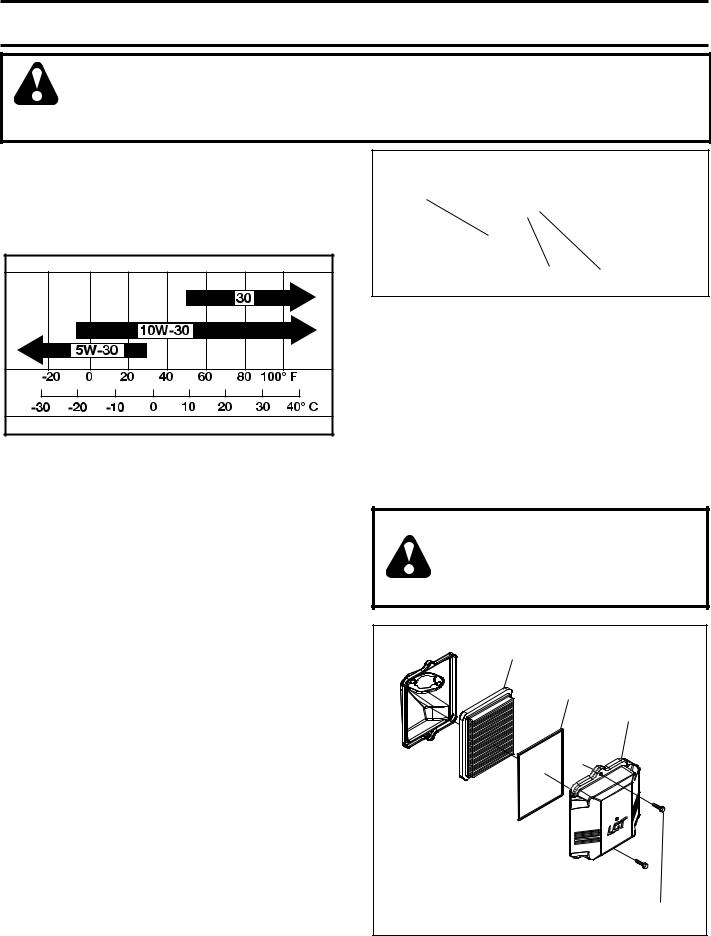
MAINTENANCE
Disconnect spark plug wire before performing any maintenance (except carburetor adjustment) to prevent accidental starting of engine.
Prevent fires! Keep the engine free of grass, leaves, spilled oil, or fuel. Remove fuel from tank before tipping unit for maintenance. Clean muffler area of all grass, dirt, and debris.
Do not touch hot muffler or cylinder fins as contact may cause burns.
ENGINE
LUBRICATION
Use only high quality detergent oil rated with API service classification SG-SL. Select the oil’s SAE viscosity grade according to your expected temperature.
ªªªªªªªªªªªªªªªªªªªªªªªªªªªªªªªªªªªª3!%ª6)3#/3)49ª'2!$%3 |
4%-0%2!452%ª2!.'%ª!.4)#)0!4%$ª"%&/2%ª.%84ª/),ª#(!.'% |
Fig. 16
NOTE: Although multi-viscosity oils (5W-30, 10W-30, etc.) improve starting in cold weather, these multi-viscosity oils will result in increased oil consumption when used above 40°F (4°C). Check your engine oil level more frequently to avoid possible engine damage from running low on oil.
Change the oil after every 25 hours of operation or at least once a year if the tiller is not used for 25 hours in one year.
Check the crankcase oil level before starting the engine and after each five (5) hours of continuous use. Add SAE 30 motor oil or equivalent. Tighten oil filler plug securely each time you check the oil level.
TO CHANGE ENGINE OIL (See Figs. 16 and 17)
Determine temperature range expected before oil change. All oil must meet API service classification SG-SL.
•Be sure tiller is on level surface.
•Oil will drain more freely when warm.
•Use a funnel to prevent oil spill on tiller, and catch oil in a suitable container.
•Remove drain plug. For easier removal of plug use 7/16 12 Pt. socket with extension.)
•Tip tiller forward to drain oil.
•After oil has drained completely, replace oil drain plug and tighten securely.
•Remove oil filler plug. Be careful not to allow dirt to enter the engine.
•Refill engine with oil. See “CHECK ENGINE OIL LEVEL” in the Operation section of this manual.
OIL
DRAIN
PLUG
OIL FILLER OIL LEVEL
PLUG
Fig. 17
AIR CLEANER (See Fig. 18)
Service air cleaner cartridge every twenty-five hours, more often if engine is used in very dusty conditions.
1.Loosen air cleaner screw.
2.Remove air cleaner cover.
3.Carefully remove air cleaner cartridge. Be careful. Do not allow dirt or debris to fall into carburetor.
4.Clean by tapping gently on a flat surface.
NOTE: If very dirty or damaged, replace cartridge.
5. Clean and replace cover. Tighten screw securely.
CAUTION: Petroleum solvents, such as kerosene, are not to be used to clean cartridge. They may cause deterioration of the cartridge. Do not oil cartridge. Do not use pressurized air to clean or dry cartridge.
Air Cleaner |
Cartridge |
Pre-Cleaner |
Cover |
Air Cleaner |
Screws |
Fig. 18
13

MAINTENANCE
COOLING SYSTEM (See Fig. 19)
Your engine is air cooled. For proper engine performance and long life keep your engine clean.
•Clean air screen frequently using a stiff-bristled brush.
•Remove blower housing and clean as necessary.
•Keep cylinder fins free of dirt and chaff.




 Muffler
Muffler
Cylinder Fins 





Air Screen |
Blower |
|
Housing |
||
Fig. 19 |
||
|
||
MUFFLER |
|
Do not operate tiller without muffler. Do not tamper with exhaust system. Damaged mufflers or spark arresters could create a fire hazard. Inspect periodically and replace if necessary. If your engine is equipped with a spark arrester screen assembly, remove every 50 hours for cleaning and inspection. Replace if damaged.
SPARK PLUG
Replace spark plugs at the beginning of each tilling season or after every 25 hours of use, whichever comes first. Spark plug type and gap setting are shown in “PRODUCT SPECIFICATIONS” on page 4 of this manual.
TRANSMISSION
Your transmission is sealed and will not require lubrication unless serviced.
CLEANING
Do not clean your tiller when the engine and transmission are hot. We do not recommend using pressurized water (garden hose, etc.) to clean your unit unless the gasket area around the transmission and the engine muffler, air filter and carburetor are covered to keep water out. Water in engine will shorten the useful life of your tiller.
•Clean engine, wheels, finish, etc. of all foreign matter.
•Keep finished surfaces and wheels free of all gasoline, oil, etc.
•Protect painted surfaces with automotive type wax.
14
